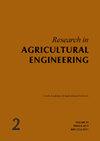用于温室气候控制系统的非线性控制模型
Q3 Agricultural and Biological Sciences
引用次数: 1
摘要
本文设计并提出了一种非线性控制系统来控制温室气候条件。该控制系统直接利用传感器的信息,安装在温室内外。为了设计该控制系统,应用了非线性控制系统的原理以及系统理论中平衡点和零动力学的概念。为了证明所提出的控制系统的能力和适用性,将其与积分滑模控制器进行了比较。在一个气候条件相似的温室中,模拟了积分滑模控制器的性能。研究结果表明,积分滑模控制系统精度更高;然而,该控制系统发出的执行器信号并不平滑。与所提出的非线性控制系统相比,它可以更快地损坏和折旧温室设备。实验还表明,根据温室外的天气条件,通过改变参考信号,温度和湿度的调节非常顺利。这两种控制系统的能力以图形方式演示了温度和湿度响应以及发送给执行器的信号。本文章由计算机程序翻译,如有差异,请以英文原文为准。
Non-linear control model for use in greenhouse climate control systems
In this study, a non-linear control system was designed and proposed to control the greenhouse climate conditions. This control system directly uses the information of sensors, installed inside and outside the greenhouse. To design this proposed control system, the principles of a non-linear control system and the concepts of equilibrium points and zero dynamics of system theories were used. To show the capability and applicability of the proposed control system, it was compared with an integral sliding mode controller. A greenhouse with similar climatic conditions was used to simulate the performance of the integral sliding mode controller. In this study, it was seen that the integral sliding mode control system was more accurate; however, the actuator signals sent by this control system were not smooth. It could damage and depreciate the greenhouse equipment more quickly than the proposed non-linear control system. It was also shown that the regulation of the temperature and humidity was performed very smoothly by changing the reference signals according to the weather conditions outside the greenhouse. The ability of these two control systems was graphically demonstrated for temperature and humidity responses as well as for the signals sent to the actuators.
求助全文
通过发布文献求助,成功后即可免费获取论文全文。
去求助
来源期刊

Research in Agricultural Engineering
Engineering, agriculture-
CiteScore
1.40
自引率
0.00%
发文量
21
审稿时长
24 weeks
期刊介绍:
Original scientific papers, short communications, information, and studies covering all areas of agricultural engineering, agricultural technology, processing of agricultural products, countryside buildings and related problems from ecology, energetics, economy, ergonomy and applied physics and chemistry. Papers are published in English.
 求助内容:
求助内容: 应助结果提醒方式:
应助结果提醒方式:


